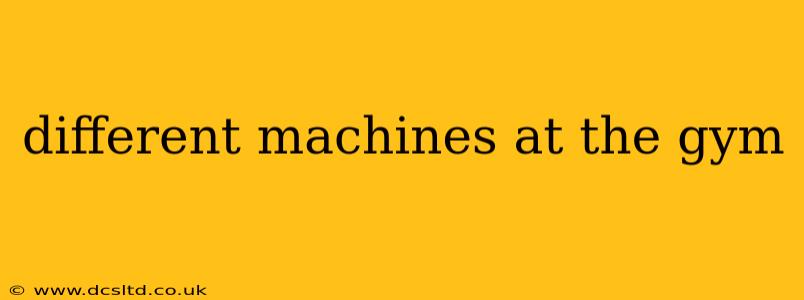The modern gym offers a dizzying array of machines, each designed to target specific muscle groups and achieve particular fitness goals. Understanding the different types of gym machines and their functions is crucial for creating an effective and safe workout routine. This guide will explore the various machines you’ll encounter, highlighting their benefits and how to use them correctly.
What are the Main Types of Gym Machines?
Gym machines broadly fall into several categories, each employing different resistance mechanisms and targeting different muscle groups. We'll explore the most common:
Weight Machines:
These machines use weight stacks and cables to provide resistance. They often guide your movement, promoting correct form and reducing the risk of injury. Popular examples include:
- Chest Press: Targets the pectoral muscles (chest). It provides a controlled movement, making it suitable for beginners and those recovering from injuries.
- Lat Pulldown: Works the latissimus dorsi (lats) muscles in the back. It’s a great exercise for building back width and strength.
- Leg Press: A powerful exercise for the quadriceps, hamstrings, and glutes (buttocks). It allows you to lift heavier weights than free weight squats.
- Leg Extension: Isolates the quadriceps muscles, helping to build leg definition.
- Hamstring Curl: Isolates the hamstring muscles, balancing the development of the quadriceps.
- Shoulder Press: Targets the deltoid muscles (shoulders). Different variations target different heads of the deltoids.
Cardio Machines:
These machines help improve cardiovascular health and burn calories. They offer varied intensities and workout experiences. Common examples include:
- Treadmills: The classic cardio machine, offering varying speeds and inclines for a customizable workout.
- Ellipticals: A low-impact option that works both the upper and lower body.
- Stationary Bikes: Another low-impact option that primarily targets the legs. Different types offer varying resistance and workout styles.
- Rowing Machines: A full-body workout that engages multiple muscle groups simultaneously. It's excellent for improving cardiovascular fitness and building strength.
- Stair Steppers: Mimics climbing stairs, providing a high-intensity cardiovascular workout.
Free Weights:
While not strictly "machines," free weights (dumbbells, barbells, kettlebells) are essential components of many gym workouts. They require more control and balance, challenging your core muscles and improving overall stability.
What are the Benefits of Using Gym Machines?
Gym machines offer several advantages:
- Guided Movement: Reduces the risk of injury by providing a controlled range of motion.
- Ease of Use: Generally easier to learn than free weight exercises.
- Targeted Muscle Isolation: Allows you to focus on specific muscle groups.
- Progressive Overload: Most machines allow you to easily increase the weight or resistance as you get stronger.
What are the Disadvantages of Using Gym Machines?
Despite their advantages, gym machines have some limitations:
- Limited Range of Motion: Can restrict the natural movement patterns of the body compared to free weights.
- Lack of Functional Movement: May not translate directly to real-world activities as effectively as free weight exercises.
- Can be Intimidating for Beginners: The sheer number of machines can be overwhelming for new gym-goers.
How Do I Choose the Right Gym Machines for My Goals?
Choosing the right machines depends on your fitness goals. For example:
- Building Muscle: Focus on weight machines targeting specific muscle groups.
- Improving Cardiovascular Health: Utilize cardio machines like treadmills, ellipticals, or rowing machines.
- Overall Fitness: Combine both weight machines and cardio machines for a balanced routine.
What are Some Common Mistakes to Avoid When Using Gym Machines?
- Using Improper Form: This is the biggest risk, potentially leading to injuries. Start with lighter weights and focus on correct technique before increasing the load.
- Ignoring Your Body's Signals: Stop if you experience pain.
- Not Warming Up: Always warm up before exercising to prepare your muscles.
- Neglecting Cool-Down: Cool down after your workout to reduce muscle soreness and promote recovery.
This guide provides a solid foundation for understanding the various gym machines and how to incorporate them into your fitness routine. Remember to consult with a fitness professional for personalized guidance and to ensure you're using the machines correctly and safely. Always prioritize proper form over lifting heavy weights.
